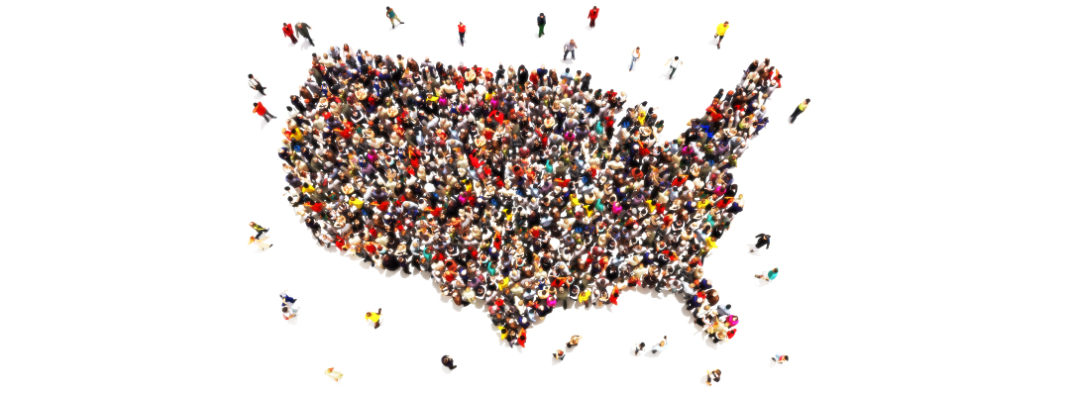
The United States has always been a nation of immigrants. Immigrants have helped build our nation, drive innovation, and spark productivity. Nearly 45% of Fortune 500 companies were started by immigrants or their children. Among other substantial contributions to society, almost 40% of American Nobel laureates since 2000 have been immigrants.
Immigration is also necessary to drive economies that do not have enough working-age adults to provide for an aging population. This is particularly true in countries like the United States, where adults are waiting longer and having fewer children.
Despite the United States’ dependence on immigration, throughout history immigrants have often been viewed with suspicion and disdain. Recent responses to Muslim immigration and immigration at the US southern border have illustrated that the issue of immigration has become a contentious political one, driven by and driving political hostility.
For instance, political leaders have fought viciously over immigration reform and have gone so far as to shut down the government due to disagreements about immigration policy. Likewise, the general public has sharp disagreements over how to handle undocumented immigration and whether undocumented immigration is even a pressing issue.
What is driving this political hostility toward immigration? My research suggests that the hostility is driven by inaccurate perceptions and narratives about immigrants themselves. Those collective stories that we tell are not just dramatically inaccurate. They are barriers to collaboration and understanding. Media, politicians, and the wiring in our brains emphasize the negative.
To replace this barrier with a bridge, we should correct inaccuracies in our collective stories about immigration. This means seeking narratives that humanize immigrants instead of demonizing them. To realize successful and bipartisan immigration reform, we should use common narratives as bridges, not barriers.
Democrats and Republicans both get the narrative wrong
Research suggests that inaccurate perceptions about the types of immigrants entering the United States might be to blame. Both Democrats and Republicans greatly overestimate the percentage of criminal immigrants entering the United States through the southern border. According to the Department of Homeland Security (DHS), less than 1% are associated with gangs or other criminal activity. However, Democrats and Republicans estimate 11% and 22%, respectively.
Likewise, according to the DHS, in 2017, only about 0.1% of the families apprehended at the border contained alleged smugglers who were using children to gain access to the country. That is, DHS statistics show that just one individual in 1,000 families who were attempting to cross at the southern border were unrelated to the children they entered with.
In the first five months of fiscal year 2018, that only rose to 0.6%—six individuals in 1,000 families. Yet Democrats and Republicans both overestimate how common this practice is, reporting 18% and 37%, respectively.
These overestimations have detrimental consequences. According to my research, they predict dehumanization and lack of empathy for immigrants. They also lead to support for harsh immigration policies—like the Trump administration’s “Zero Tolerance” policy that separated children from their parents when they crossed the border.
The media relays inaccurate immigration narratives
The media is one of the prominent sources of inaccurate information about the types of immigrants entering the US. Narratives about immigrant criminality permeate both conservative and liberal news outlets. When the media focuses on negative news stories about immigrants being dangerous, criminal, or taking advantage of resources, Americans are less willing to welcome immigrants into their communities and accept them once they are here.
However, when people watch news stories that humanize immigrants—such as the tearful reunification of an undocumented mother and her daughter after being separated at the southern border—and receive accurate information about the types of immigrants entering the United States, their attitudes toward immigrants become more positive. That is, people are more likely to humanize immigrants, feel empathy toward them, and express less support for harsh anti-immigrant policies.
Immigration compromise between Democrats and Republicans is possible
Perceptions about immigrants are only one barrier to immigrant acceptance.
In order to change the landscape of immigration processes in the United States, both Democrats and Republicans should work together to enact pro-immigration reform. This might seem unlikely given the media’s narratives about the unbridled polarization between the parties.
Recent research suggests that partisans might agree more than they think they do—even about immigration. When representative samples of Democrats and Republicans are asked their views on immigration policy, they understandably have different opinions. However, this difference is smaller than many people expect.
When asked to rate how much they favor closed versus open borders on a scale of 0 (completely closed borders) to 100 (completely open borders), Democrats and Republicans were about 36 points apart in their opinions.
This disagreement is not negligible, but it is much smaller than the expected disagreement. That is, when partisans were asked to estimate how far apart Democrats and Republicans are on border policy preferences, the average estimates were 52 and 66 points apart, respectively.
Emerging research from the Peace & Conflict Neuroscience Lab at the University of Pennsylvania, where I am the director, suggests that when the narrative about political division shifts and voters learn that their immigration policy preferences are not as substantially different as they thought, voters are more likely to endorse bipartisan collaboration on important social issues such as immigration reform.
The solution is in the problem
In order to overcome barriers to immigration, there needs to be a collective narrative shift in how immigrants are portrayed in the media and how partisan attitudes about immigration reform are discussed.
Humans are social beings. We are more likely to believe people that are similar to us, and we weight their opinions more than the opinions of people less like us. We seek information that confirms our existing worldviews and filter information to be consistent with our existing beliefs.
These human tendencies make it difficult to shift our personal views, especially on immigration. Compounding this difficulty are the media’s narratives portraying immigrants as the enemy or magnifying divisions between partisans. For example, referring to immigrants as swarms (as David Cameron did during the Brexit debates) or invaders as has been common in American policy discussions.
If we want to shift our reactions to immigrants and change the collective narrative, we need to realize the biases hidden in our brains. These biases shape the media that we consume and how we interpret what the media reports.
With every post we engage with on social media or every time we search for a particular topic on the web, we are alerting media networks to the ideas we care about. The media then uses this information to provide us with targeted content that is consistent with and reinforces our past engagements.
Given that both conservative and liberal media highlight harmful narratives about immigration and use dehumanizing language to describe immigrants, it is likely that this information is contributing to the negative narrative about immigration.
This continuous thrust of targeted content then propels us into an echo chamber of opinion-confirming news that paints immigration in a negative light. However, once we recognize that the information we receive is meant to confirm our existing biases and beliefs, then we can break out of our echo chambers and seek new information.
After distinguishing the factual from the fabricated, opinions on immigration will shift in a positive direction.
How to correct our misperceptions of immigrants
Of course, breaking free of our echo chambers is easier said than done. It requires us to actively seek out information that might go against our pre-existing biases to obtain up-to-date, factual information.
Individuals, policymakers, and members of the media can all take steps to help correct our misperceptions of immigrants.
Individuals
Individuals can start with the following steps:
- Remember that the news is not only subject to a negativity bias, but as media consumers, we place more weight on negative news stories than positive ones.
- Actively engage with positive immigration information sources. Podcasts such as Immigrantly and Modern Immigrant help dispel stereotypes and myths about immigrants while providing perspectives on issues related to immigration. Prominent pro-immigrant influencers provide their positive perspectives on immigration as well.
- Learn about the immigrant experience, and if you are an immigrant, share your story through programs such as My Immigration Story and the University of Minnesota’s Immigrant Stories project.
- Follow nonpartisan immigration groups, such as American Immigration Council, to find accurate stories and reporting on immigration policy.
- Question the bias in every immigration news story. Whether the news source is liberal or conservative, it may still have a negative immigration bias. Check out organizations such as AllSides for balanced news coverage of pressing social issues.
- Fact check the information you encounter with independent, nonpartisan fact-checking sites, such as Snopes or FactCheck.org, before sharing it on social media or with friends.
- Share pro-immigrant stories you encounter with your network and on social media.
This careful attention can be self-enlightening, and it can prevent the spread of negative immigration stories and misinformation.
Policymakers and public figures
Just like the general public, policymakers and other public figures can also fall victim to negative and inaccurate information about immigrants. Policymakers and other public figures have platforms they can use to prevent the spread of negative and inaccurate information about immigrants.
Policymakers and public figures should consider the following steps:
- Be vigilant about the immigration information you consume.
- Prevent the spread of misinformation, especially when striving to promote bipartisan immigration policy reform. Take extra care to ensure the information you promote is accurate.
- Share stories about collaborating with those across the aisle in order to show that bipartisan immigration reform is possible. For instance, organizations, such as the Alliance for a New Immigration Consensus, bring together advocates and leaders from across different fields to come up with bipartisan solutions to immigration reform.
- Lead by example by sharing positive stories about immigrants and promoting policies that support immigration.
These steps will help pave the way for a positive shift in the collective narrative about immigration.`
Journalists and media outlets
Journalists and media outlets also hold the power to shift the collective narrative about immigration.
Journalists and media makers can:
- Use thoughtful language to describe immigrants.
- Highlight how Democrats and Republicans are not as polarized on immigration reform as usually portrayed. Organizations, such as The American Press Institute, have already started to pave the way on how to engage in journalistic practices that foster unity in today’s political landscape.
- Focus on positive narratives about immigrants, which in reality occur more often than the negative stories.
- Prevent the spread of misinformation by promoting nonpartisan facts about immigrants and immigration.
- Promote high-quality research that elucidates key issues about immigration. Organizations, such as The Journalist’s Resource, can help synthesize research and bridge the gap between academia and journalism.
We can change the immigration narrative. It starts with examining our individual biases, but ultimately, it must be a collective effort.
In doing so, we rehumanize a group of people that has been dehumanized far too long.

